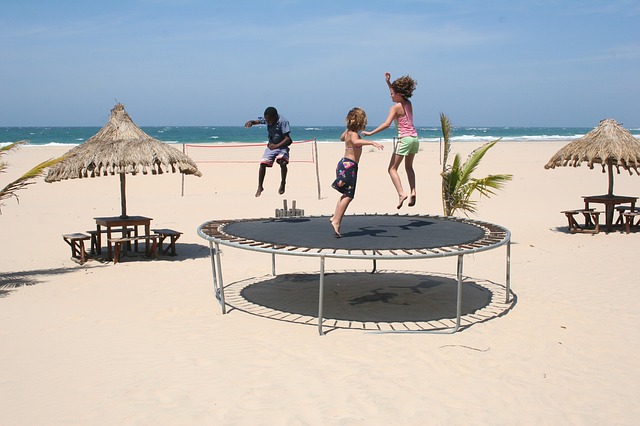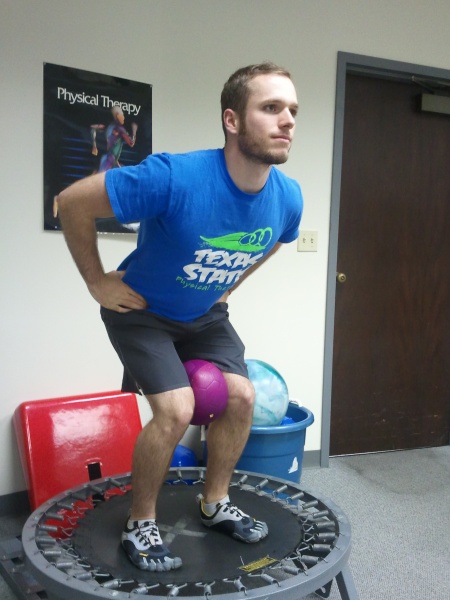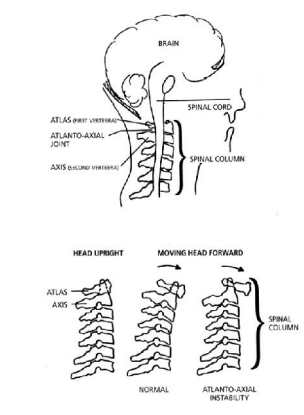Rebound Therapy
Original Editor - Alex Curran
Top Contributors - Alex Curran, Kim Jackson, Mandy Roscher, Oyemi Sillo, Rachael Lowe, Tarina van der Stockt, WikiSysop, Simisola Ajeyalemi, Robin Tacchetti, Admin, Scott Buxton, Amrita Patro, Wanda van Niekerk and Jess Bell
Description[edit | edit source]
Rebound therapy is the use of of a trampoline for physical therapy in order to develop and promote motor skills, body awareness, balance, coordination and communication . Though the idea of using trampolines in special education has existed since the 1950s it was not until the 1980s that the concept of Rebound Therapy was developed by a physiotherapist named Eddy Anderson who worked with children with both physical and learning disabilities [1]
In 1992, following interest from the Chartered Society of Physiotherapy and the British Trampoline Association Eddy Anderson provided training courses to both organisations in the use and implementation of Rebound Therapy following many years of working in education delivering Rebound Therapy on staff development courses. In 2011 and 2012 Rebound Therapy has been piloted and introduced across both Malaysia and Australia respectively.
The phrase Rebound Therapy, when correctly applied describes a specific methodology, assessment and programme of use of trampolines to provide opportunities for enhanced movement patterns, therapeutic positioning, exercise and recreation for a wide range of users with additional needs. When working with individuals in Rebound Therapy, if appropriate, progress can be accurately measured and recorded using the Huddersfield Functional Index in conjunction with the Winstrada development programme.
Since it's inception Rebound Therapy has expanded beyond its original user base and is being used with an increasingly expanding client base. Rebound Therapy should always be used as part of a therapy programme and not just as a modality on its own in isolation.
Benefits of Rebound Therapy[edit | edit source]
Rebound Therapy can provide multiple benefits including the development and improvement of:
- Exercise tolerance and stamina
- Balance
- Muscle tone
- Reaction speeds
- Proprioception
- Height and depth perception
- Coordination
- Eye contact
Less obvious benefits (and more anecdotal in nature) that have been observed include improved:
- Patience
- Communication
- Independence
- Self-confidence
- Self-image.
- Relaxation
- A sense of achievement
- Social awareness
- Consideration of other
- Trust and confidence in the coach and assistants
- Fun and enjoyment.
Contraindications[edit | edit source]
Listed below are the known contraindications for Rebound Therapy. If any of the following are present, the physiotherapist will use their clinical knowledge and judgement and seek appropriate advice and medical information in order to make an informed decision about modification of treatment or whether a potential service user is unsuitable to take part in Rebound Therapy:
- Cardiac or circulatory problems
- Downs Syndrome
- Respiratory problems
- Vertigo
- Blackouts or nausea
- Epilepsy
- Spinal cord or neck problems
- Spinal rodding
- Open wounds
- Any recent medical attention
- Brittle bones/osteoporosis
- Friction effects on the skin
- Unstable/hypermobile/painful joints
- Herniae
- Implant surgery (e.g. Baclofen pump)
- Prolapse
- Severe challenging behaviour
- Gastrostomy/colostomy
- Gastric reflux
- Stress Incontinence
- Joint replacement [2]
Absolute Contraindications[edit | edit source]
The following three are absolute contraindications for Rebound Therapy and under no circumstances should they be performed due to the risks posed to anyone with either of the three contraindications:
- Pregnancy-Trampolining during pregnancy can cause disruptions to the womb and has the potential to cause harm to an unborn
baby. Also, the extra strain of such a high energy sport may cause damage to the mother whose vital organs are already functioning at a higher than normal level. - Detaching retina-This disorder is caused when the retina (then thin layer at the back of the eye, responsible for light detection)starts to separate from the eye socket. It can cause blindness if not treated early. Trampolining can cause the retina to completely detach, leading to total blindness.
- Atlantoaxial instability (AAI)- A condition associated with 10-40% of people with Down’s Syndrome. Weakened ligaments is normal in people with Down’s Syndrome, causing slack joints. This may cause a weakness in the Atlanto- Axial joint of the first (Atlas) and second (Axis) vertebrae, right below the skull. This makes sufferers of AAI prone to a slippage of these vertebrae which can cause brain damage and paralysis. The image directly below demonstrates AAI[2][3]
Conditions that can be treated with Rebound Therapy [edit | edit source]
Rebound Therapy, as stated above, can provide a large array of benefits for a large group of patient groups. As a physiotherapy intervention one of Rebound Therapy's primary aims is to impact upon muscle tone disorders such as However it is important to provide information on the type of conditions which may benefit from Rebound Therapy. It is important to remember that the conditions that will be elaborated upon are not the only ones which can benefit from Rebound Therapy.
The following conditions stand to benefit from Rebound Therapy:
Hypertonia
Hypertonia is increased tightness in the muscle tone which reduces the capacity of the muscle tissue to stretch. This is caused by damage to the motor pathways in the central nervous system which carry information from the central nervous system to the muscles which control basic activities such as posture, muscle tone and muscle reflexes. Left untreated hypertonia can cause severe pain, reduced quality of life, loss of function and deformity. In the most severe of cases hypertonia can completely stop joint movement. There are two types of hypertonia; spastic hypertonia and dystonic hypertonia.
- Spastic hypertonia- Spastic hypertonia can be caused by a number of conditions such as; cerebral palsy, stroke, spinal cord injury. This variant of spastic hypertonia leads to uncontrolled muscle spasms, stiffening and straightening of the muscles and sudden contractions of all or part of the muscle leading to abnormal muscle tone.
- Dystonic hypertonia- This refers to the resistance of the passive stretching of muscles (passive stretching of muscles occurs when the physiotherapist stretches the muscle at a low velocity to a comfortable length). Dystonic hypertonia also refers to when the muscle returns to its previously fixed position following movement. This type of hypertonia is most common in Parkinsonism.
Hypotonia
Hypotonia is a state of low muscle tone which can often lead to reduced muscle strength. Hypotonia is not the same as muscle weakness but it can sometimes be difficult to utilise the muscle which exhibit low tone. Muscle weakness can develop in association with hypotonia dependent on the underlying cause of the hypotonia. Hypotonia in of itself is not a specific medical condition but is a manifestation of one or several conditions.
Autistic Spectrum Disorders
Rebound Therapy can also useful in the treatment of inidividuals with Autistic Spectrum Disorders (ASDs). During Rebound Therapy the individual with an ASD will be paired with a qualified Rebound Therapy instructor, in most cases a physiotherapist, who will be tasked with leading a treatment session. This is a great example of how Rebound Therapy can improve focus and concentration and improve the ability to maintain eye contact as the child with an ASD will need to focus and pay attention to the instructions provided by the Rebounder. With Rebound Therapy being originally developed in the educational environment an opportunity to improve attentiveness and concentration is an often welcomed opportunity for child development.
Equipment Requirements/Training Requirements/Safety[edit | edit source]
Training Requirements
Rebound Therapy can only be carried out by therapists who have received training and have gained practical experience by attending a Rebound d Therapy course which may typically be part of the Winstrada Development Programme. While the physiotherapist remains responsible for the overall assessment and re-evaluation of the Rebound Therapy service user, the modality itself can be delivered by other trained individuals. When delivered in the stereotypical special education environment with which Rebound Therapy is most closely associated, this means it may be delivered by teachers, teaching assistants, support workers and speech and language therapists.
Equipment/Personnel Requirements
For safety reasons Rebound Therapy can be resource intensive due to the number of spotters required around the trampoline to ensure the safety of the service user. In addition to this the facilities required for the safe practice of Rebound Therapy may be hard to find. A ceiling height of 4.87 metres is indicated as the safe minimum ceiling height for the delivery of Rebound Therapy. Ceiling heights can be lower but the service user should not be bouncing more than 30 centimetres off the trampoline surface.
In addition to the ceiling height the environment must be able to contain a regular sized trampoline. Due to the unique needs of the equipment Rebound Therapy is both staff intensive and as a result cost intensive. This is in addition to the large setup cost of equipment. As a result of the staff requirements and equipments and cost requirements it may be difficult to effectively and safely implement Rebound Therapy in some settings.
Key Evidence[edit | edit source]
While there are many listed benefits of Rebound Therapy the evidence behind these benefits is minimal [4][5]. Despite this apparent lack of evidence Rebound Therapy is commonly used by Special Needs Educational Schools as a means of providing movement and physical experiences for those with physical disabilities despite having no empirical data displaying its benefits. Plenty of evidence has been provided anecdotally by physiotherapists performing the modality and there has been evidence from a few studies but it is not a practice that has been extensively researched. Anecdotally, it has been collectively agreed that Rebound Therapy does help to improve muscle tone, but again, this is not supported by any concrete evidence [5]
Previously the CSP has identified Rebound Therapy as an area of physiotherapy which would benefit from further research[4]. Given the high costs associated with Rebound Therapy in comparison to other alternative treatments there is a definite need to carry out further research into the area to compare it to more traditional interventions to see if there is a more significant benefit to Rebound Therapy which could in turn justify the higher costs.
One thing to consider however is the "fun" aspect of Rebound Therapy due to the very nature of the equipment involved. Considering the main client group likely to be involved in Rebound Therapy (children), the fact that the use of a trampoline is more likely to hold the attention of a child and as a result increased engagement with the modality. Due to increased willingness to engage with Rebound Therapy this means Rebound Therapy may hold an advantage over more traditional modalities which may be considered "boring" in comparison. This is especially important in children with learning disabilities who may be at a predisposition to become inattentive. To summarise, Rebound Therapy is especially effective in client groups who would usually be resistant to Rebound Therapy.[1] [3]
Resources[edit | edit source]
The below video gives an example on the uses of Rebound Therapy. While not exhaustive, this video provides a good example of the range of techniques that are used in Rebound Therapy.
Case Studies[edit | edit source]
The following are examples of a Rebound Therapy session that may take place:
Recent Related Research (from Pubmed)[edit | edit source]
References[edit | edit source]
- ↑ 1.0 1.1 Eddy Anderson. What is Rebound Therapy? http://www.reboundtherapy.org/papers/rebound_therapy/what_is_rebound_therapy.pdf (Accessed Online April 5th 2015).
- ↑ 2.0 2.1 2.2 Chartered Society of Physiotherapy. Safe practice infckLRrebound therapy. London: Chartered Society of Physiotherapy, 2007.
- ↑ 3.0 3.1 Thomas Sanderson. A report on Rebound Therapy’s usefulness with Children with Disabilities. http://www.reboundtherapy.org/papers/rebound_therapy/RT_usefulness_with_disabled_children_Tom_Sanderson.pdf (Accessed April 5th 2015).
- ↑ 4.0 4.1 Chartered Society of Physiotherapy. Priorities for Physiotherapy Research in the UK: Topics Prioritised by the Mental Health and Learning Disabilities Expert Panel. London: Chartered Society of Physiotherapy, 2002.
- ↑ 5.0 5.1 Watterston, R. and Delahunty, M. A Pilot Study Investigating the Use of Rebound Therapy for Clients with a Learning Disability. Part of: Huddersfield Functional Index: Rebound Therapy Outcome Measures Toolkit. Huddersfield: Huddersfield NHS Trust, 2001.









